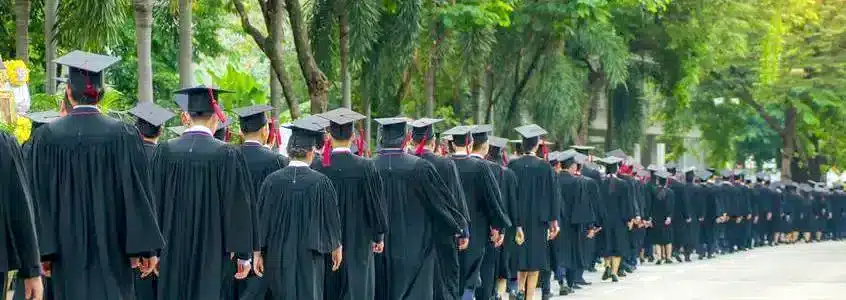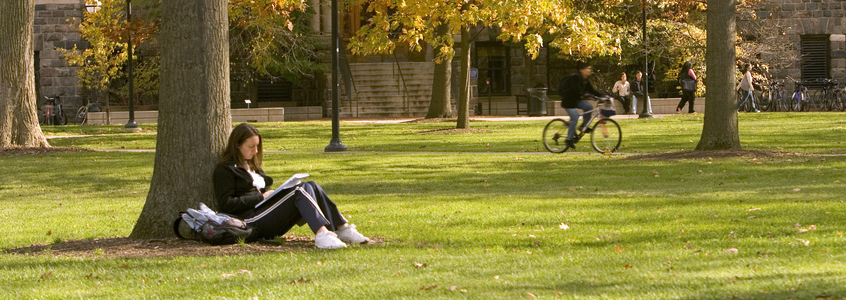
Date Dive: Spotlighting Gaps in Postsecondary Attainment
Additional Findings from the High School Benchmarks Report
As communities work to improve educational outcomes, data from the National Student Clearinghouse Research Center’s High School Benchmarks report continues to reveal critical insights. One of the most striking findings in the latest benchmarks is the persistent gap in postsecondary enrollment and completion based on income and poverty levels at the high school level.
For the class of 2024, only 52.3% of graduates from low-income high schools, where at least 50% of the entire student population are eligible for free or reduced-price lunch, enrolled immediately in postsecondary education. In contrast, 64.2% of graduates from higher-income high schools made that transition, a difference of nearly 12 percentage points. The disparity is even more pronounced when looking at poverty levels: just 51.4% of graduates from high-poverty high schools, where at least 75% of the student population is eligible for free or reduced-price lunch, enrolled in college right after graduation, compared to 74.2% from low-poverty schools.
But the gap doesn’t stop at enrollment. When we look at degree completion six years after graduating high school, the divide becomes even more stark. Among the class of 2018, only 24.9% of students from high-poverty high schools completed a college degree, while 58.7% of their peers from low-poverty schools did so. That’s a 33.8 percentage point difference, meaning students from low-poverty schools were more than twice as likely to earn a degree.
“The High School Benchmarks report offers visibility into how socioeconomic factors shape students’ educational journeys,” said Matt Holsapple, Senior Director of Research at the National Student Clearinghouse. “These insights can help empower educators and policymakers to build more equitable systems that support all learners.”
The report also reveals significant disparities in STEM degree completion based on high school characteristics. Graduates from high-poverty and low-income high schools earn STEM degrees at much lower rates (just 8.1% and 9.1%, respectively) within six years of graduation. In contrast, students from low-poverty and higher-income schools see much higher completion rates, with rates of 22.4% and 17.5%, respectively.
Holsapple added, “The High School Benchmarks report helps uncover critical gaps in degree fields like STEM, where access and completion rates often vary by region and socioeconomic status. By identifying these disparities, educators and policymakers can better target resources and create pathways that support students in pursuing high-demand careers.”
Explore Postsecondary Trends with the High School Benchmarks Dashboard
The High School Benchmark report’s interactive dashboard allows users to explore postsecondary enrollment trends based on key high school characteristics, including poverty rates, income levels, minority representation, and urbanicity. By analyzing these factors, educators and community leaders can uncover disparities and design more targeted strategies to support equitable access to higher education.
StudentTracker Helps Low-Income High Schools Measure Graduates’ Postsecondary Success
The High School Benchmark’s report is made possible through data collected for the Clearinghouse’s StudentTracker for High Schools, a powerful tool that provides enrollment and degree data from nearly 3,600 colleges and universities, covering over 97% of all students in U.S. public and private institutions. With this data, educators and community leaders can track postsecondary trends and better understand where gaps exist. These insights can inform targeted interventions that help ensure every student has a fair and equitable opportunity to succeed beyond high school.
For example, in Iowa, nearly 42% of students are eligible for free or reduced-price lunches, according to the Iowa Department of Education’s Annual Condition of Education Report: 2024. Recognizing the challenges this presents, the United Way Muscatine County leads a community program aimed at expanding access to higher education for students from low-income backgrounds.
This targeted approach helps high schools in Muscatine County design effective strategies to support underserved students and improve long-term outcomes. One example is a summer melt mentorship program, which eases students’ transition into higher education. Learn more about how the United Way Muscatine County uses StudentTracker for High Schools to enhance student success.
Additional Resources:
StudentTracker users: Outsource your diploma verifications for free
Participating in both StudentTracker and DiplomaVerify is the best way for high schools and districts to maximize the value of their student data — for themselves and their students.
Take a deep dive into the latest learner insights
Explore our free and timely research reports and interactive dashboards for insights into higher education trends.



